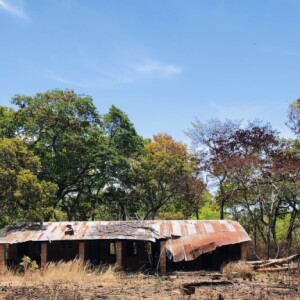Unscavenged
We motored around the hilly tracks of the Niassa-Selous Wildlife Corridor. At a large waterhole we discovered this hippo carcass, which had died naturally, probably due to conflict with another male in the pod. It was a few days old at least but there were very limited signs of scavenging by hyena or vulture. This isn’t a good sign for a healthy ecosystem, indicating that wildlife numbers are low, likely due to historical bushmeat poaching and the gradual encroachment of human activity. The challenges of what in the biz we like to term ‘human-wildlife co-existence’ are very real in the Ruvuma region. But I am enamoured by this region. It’s interesting stumbling on hippo carcasses as part of your work.
This is quite close to a place called Likuyu, where there are the ruins of a refugee resettlement complex established decades ago during the Mozambique Civil War. One of the dilapidated buildings is added as an extra. Tanzania hosted tens of thousands of refugees during that war, many of whom would never have repatriated to Mozambique especially if they are from the Yao or Makonde tribes which straddle the border. It was a great act of solidarity by the Tanzanian government to prepare facilities and land for a large number of arrivals, who became self-sufficient in a short time due to their resourcefulness. Later a new permanent village for the arrivals was established close by, named Mandela, after Nelson. The miombo woodland around the refugee centre has largely reclaimed itself, testament to its rewilding potential. And some of the abandoned buildings were converted into a training centre for conservation rangers and guides, which is a busy hub of activity today.


Comments
Sign in or get an account to comment.


